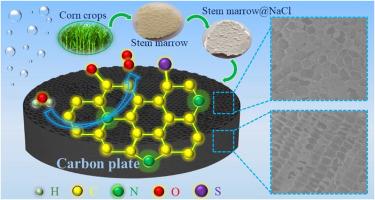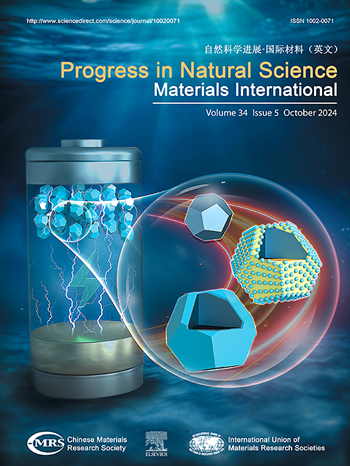Unraveling the oxygen evolution activity of biomass-derived porous carbon plate as self-supported metal-free electrocatalyst for water splitting
IF 4.8
2区 材料科学
Q2 MATERIALS SCIENCE, MULTIDISCIPLINARY
Progress in Natural Science: Materials International
Pub Date : 2024-10-01
DOI:10.1016/j.pnsc.2024.07.007
引用次数: 0
Abstract
Developing the efficient and low-cost electrocatalysts derived from biomass is a desired solution to address economy and sustainability challenges of hydrogen production from water electrolysis due to utilizing metal-based catalysts. Herein, the peeled cornstalk-derived porous carbon plates synthesized by salt template-assisted high-temperature pyrolysis are utilized as self-supported metal-free electrocatalysts to unravel the oxygen evolution activity for alkaline water splitting. The resultant PC-700-10 honeycomb carbon catalyst exhibits the superior electrocatalysis for oxygen evolution owning to its high specific surface area of 52.0 m2 g−1, suitable micro- and meso-pores, electron-withdrawing pyridinic-N moiety and appropriate balance between hydrophilicity and electroconductivity. Theoretical calculations reveal that the largest energy barrier of forming ∗OOH limits the OER rate and ∗OH oxidation generates the energetically more favorable epoxide intermediate. This finding opens the way to construct the hopeful metal-free OER electrocatalysts via regulating their intrinsic structure, and inspires the applications of waste biomass in the energy-correlated fields.

揭示生物质衍生多孔碳板作为自支撑无金属电催化剂在水分离中的氧进化活性
开发高效、低成本的生物质电催化剂是解决电解水制氢过程中因使用金属催化剂而面临的经济性和可持续性挑战的理想解决方案。在本文中,利用盐模板辅助高温热解合成的去皮玉米秆衍生多孔碳板作为自支撑无金属电催化剂,揭示了碱性水分离的氧进化活性。由于 PC-700-10 蜂窝碳催化剂具有 52.0 m2 g-1 的高比表面积、合适的微孔和中孔、具有电子吸收性的吡啶-N 分子以及亲水性和导电性之间的适当平衡,因此在氧进化方面表现出卓越的电催化性能。理论计算显示,形成 ∗OOH 的最大能量障碍限制了 OER 的速率,而 ∗OH 氧化会产生能量上更有利的环氧化物中间体。这一发现为通过调节其内在结构构建无金属 OER 电催化剂开辟了希望之路,并为废弃生物质在能源相关领域的应用提供了启发。
本文章由计算机程序翻译,如有差异,请以英文原文为准。
求助全文
约1分钟内获得全文
求助全文
来源期刊
CiteScore
8.60
自引率
2.10%
发文量
2812
审稿时长
49 days
期刊介绍:
Progress in Natural Science: Materials International provides scientists and engineers throughout the world with a central vehicle for the exchange and dissemination of basic theoretical studies and applied research of advanced materials. The emphasis is placed on original research, both analytical and experimental, which is of permanent interest to engineers and scientists, covering all aspects of new materials and technologies, such as, energy and environmental materials; advanced structural materials; advanced transportation materials, functional and electronic materials; nano-scale and amorphous materials; health and biological materials; materials modeling and simulation; materials characterization; and so on. The latest research achievements and innovative papers in basic theoretical studies and applied research of material science will be carefully selected and promptly reported. Thus, the aim of this Journal is to serve the global materials science and technology community with the latest research findings.
As a service to readers, an international bibliography of recent publications in advanced materials is published bimonthly.
文献相关原料
公司名称
产品信息
阿拉丁
Sodium chloride (NaCl)
阿拉丁
Sulfuric acid (H2SO4)
阿拉丁
Potassium hydroxide (KOH)

 求助内容:
求助内容: 应助结果提醒方式:
应助结果提醒方式:


